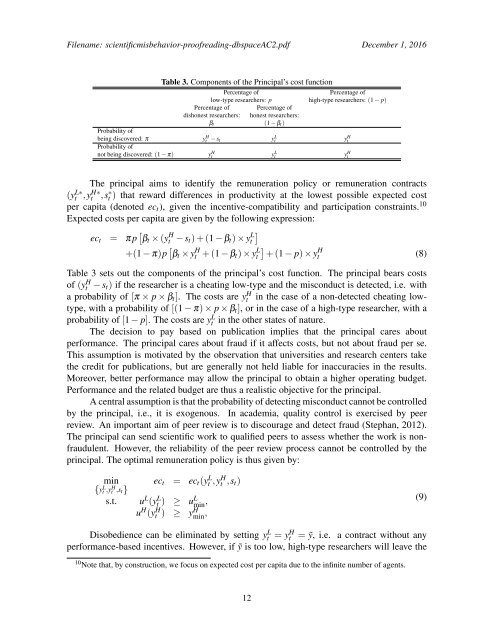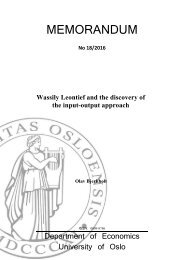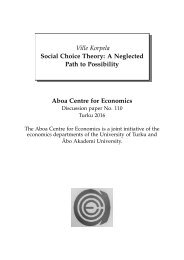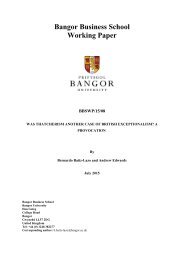Cheat Perish? A Theory Scientific Customs
n?u=RePEc:tut:cccrwp:2016-03-ccr&r=hpe
n?u=RePEc:tut:cccrwp:2016-03-ccr&r=hpe
Create successful ePaper yourself
Turn your PDF publications into a flip-book with our unique Google optimized e-Paper software.
Filename: scientificmisbehavior-proofreading-dbspaceAC2.pdf December 1, 2016<br />
Table 3. Components of the Principal’s cost function<br />
Percentage of<br />
Percentage of<br />
low-type researchers: p high-type researchers: (1 − p)<br />
Percentage of Percentage of<br />
dishonest researchers: honest researchers:<br />
β t (1 − β t )<br />
Probability of<br />
being discovered: π yt H − s t yt L yt<br />
H<br />
Probability of<br />
not being discovered: (1 − π) yt H yt L yt<br />
H<br />
The principal aims to identify the remuneration policy or remuneration contracts<br />
(yt<br />
L∗ ,yt<br />
H∗ ,st ∗ ) that reward differences in productivity at the lowest possible expected cost<br />
per capita (denoted ec t ), given the incentive-compatibility and participation constraints. 10<br />
Expected costs per capita are given by the following expression:<br />
ec t = π p [ β t × (yt H − s t ) + (1 − β t ) × yt<br />
L ]<br />
+(1 − π)p [ β t × yt H + (1 − β t ) × yt<br />
L ]<br />
+ (1 − p) × y<br />
H<br />
t (8)<br />
Table 3 sets out the components of the principal’s cost function. The principal bears costs<br />
of (yt<br />
H − s t ) if the researcher is a cheating low-type and the misconduct is detected, i.e. with<br />
a probability of [π × p × β t ]. The costs are yt<br />
H in the case of a non-detected cheating lowtype,<br />
with a probability of [(1 − π) × p × β t ], or in the case of a high-type researcher, with a<br />
probability of [1 − p]. The costs are yt L in the other states of nature.<br />
The decision to pay based on publication implies that the principal cares about<br />
performance. The principal cares about fraud if it affects costs, but not about fraud per se.<br />
This assumption is motivated by the observation that universities and research centers take<br />
the credit for publications, but are generally not held liable for inaccuracies in the results.<br />
Moreover, better performance may allow the principal to obtain a higher operating budget.<br />
Performance and the related budget are thus a realistic objective for the principal.<br />
A central assumption is that the probability of detecting misconduct cannot be controlled<br />
by the principal, i.e., it is exogenous. In academia, quality control is exercised by peer<br />
review. An important aim of peer review is to discourage and detect fraud (Stephan, 2012).<br />
The principal can send scientific work to qualified peers to assess whether the work is nonfraudulent.<br />
However, the reliability of the peer review process cannot be controlled by the<br />
principal. The optimal remuneration policy is thus given by:<br />
min<br />
{y L t ,y H t ,s t}<br />
ec t = ec t (y L t ,y H t ,s t )<br />
s.t. u L (y L t ) ≥ u L min ,<br />
u H (y H t ) ≥ y H min , (9)<br />
Disobedience can be eliminated by setting yt L = yt<br />
H = ỹ, i.e. a contract without any<br />
performance-based incentives. However, if ỹ is too low, high-type researchers will leave the<br />
10 Note that, by construction, we focus on expected cost per capita due to the infinite number of agents.<br />
12





